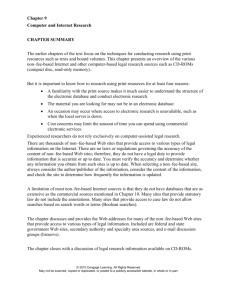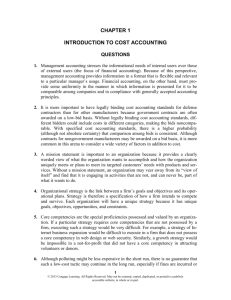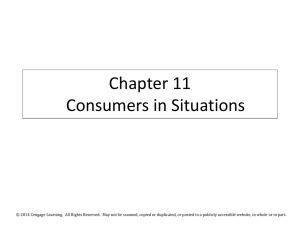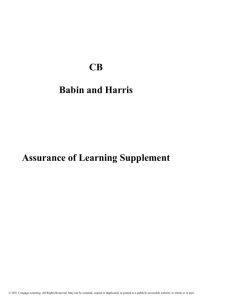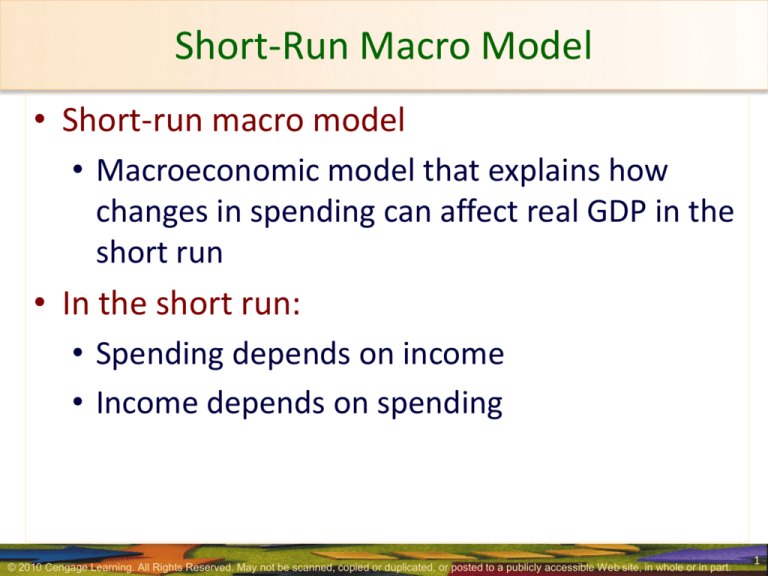
Short-Run Macro Model
• Short-run macro model
• Macroeconomic model that explains how
changes in spending can affect real GDP in the
short run
• In the short run:
• Spending depends on income
• Income depends on spending
© 2010 Cengage Learning. All Rights Reserved. May not be scanned, copied or duplicated, or posted to a publicly accessible Web site, in whole or in part.
1
Consumption Spending
• Consumption spending increases when:
•
•
•
•
Disposable income rises
Wealth rises
The interest rate falls
Households become more optimistic about
the future
© 2010 Cengage Learning. All Rights Reserved. May not be scanned, copied or duplicated, or posted to a publicly accessible Web site, in whole or in part.
2
Figure 1: Quarterly U.S. Consumption and Disposable Income, 2000–2009
When real
consumption
expenditure is
plotted against real
disposable income,
the resulting
relationship is very
close to linear: As
real disposable
income rises, so does
real consumption
spending
© 2010 Cengage Learning. All Rights Reserved. May not be scanned, copied or duplicated, or posted to a publicly accessible Web site, in whole or in part.
3
Consumption Spending
• Consumption function
• Positively sloped relationship
• Between real consumption spending and real
disposable income
• Autonomous consumption spending
• The part of consumption spending
• That is independent of income
• Vertical intercept of the consumption function
© 2010 Cengage Learning. All Rights Reserved. May not be scanned, copied or duplicated, or posted to a publicly accessible Web site, in whole or in part.
4
Table 1: Hypothetical Data on Disposable Income and Consumption
© 2010 Cengage Learning. All Rights Reserved. May not be scanned, copied or duplicated, or posted to a publicly accessible Web site, in whole or in part.
5
Figure 2: The Consumption Function
Real
Consumption
Spending 8,000
($ billions)
7,000
6,000
5,000
4,000
The consumption function shows
the (linear) relationship between
real consumption spending and
Consumption
real disposable income.
Function
The vertical intercept ($2,000
billion) is autonomous
consumption spending . . .
Consumption
Function
600
1,000
3,000
2,000
and the slope of the line
(0.6) is the marginal
propensity to consume.
1,000
1,000
2,000
3,000
4,000
5,000
6,000
7,000
8,000
Real Disposable Income ($ billions)
© 2010 Cengage Learning. All Rights Reserved. May not be scanned, copied or duplicated, or posted to a publicly accessible Web site, in whole or in part.
6
Consumption Spending
• Marginal propensity to consume (MPC) is
• The slope of the consumption function
• The change in consumption divided by the
change in disposable income
• The amount by which consumption spending
rises when disposable income rises by one
dollar
0 < MPC < 1
© 2010 Cengage Learning. All Rights Reserved. May not be scanned, copied or duplicated, or posted to a publicly accessible Web site, in whole or in part.
7
Consumption Spending
• Straight line consumption function
C = a + b ˣ (Disposable income)
• a – vertical intercept of the consumption
function
• b – slope of the consumption function
© 2010 Cengage Learning. All Rights Reserved. May not be scanned, copied or duplicated, or posted to a publicly accessible Web site, in whole or in part.
8
Consumption Spending
• Consumption and income
• Assume net taxes = fixed amount
• Consumption–income line
• A line showing aggregate consumption
spending
• At each level of income or GDP
© 2010 Cengage Learning. All Rights Reserved. May not be scanned, copied or duplicated, or posted to a publicly accessible Web site, in whole or in part.
9
Table 2: The Relationship between Consumption and Income
© 2010 Cengage Learning. All Rights Reserved. May not be scanned, copied or duplicated, or posted to a publicly accessible Web site, in whole or in part.
10
Figure 3: The Consumption–Income Line
Real
Consumption
Spending
($ billions) 5,600
Consumption–
Income
Line
B
5,000
4,000
3,000
A
2. The line has the same
slope as the consumption
function in Figure 2 . . .
Consumption
Function
600
1,000
2,000
1,000
3. but a different
vertical intercept.
1,000 2,000 3,000 4,000 5,000 6,000 7,000 8,000 9,000
1. To draw the consumption–income line, we measure real income
Real Income ($ billions)
(instead of real disposable income) on the horizontal axis.
© 2010 Cengage Learning. All Rights Reserved. May not be scanned, copied or duplicated, or posted to a publicly accessible Web site, in whole or in part.
11
Consumption Spending
• Fixed taxes
• Consumption-income line shifts downward
• By the amount of the tax times the marginal
propensity to consume (MPC)
• The slope = MPC, unaffected by taxes
© 2010 Cengage Learning. All Rights Reserved. May not be scanned, copied or duplicated, or posted to a publicly accessible Web site, in whole or in part.
12
Consumption Spending
• Income - increase
•
•
•
•
With no change in taxes
Disposable income – increase
Consumption spending – increase
Movement rightward along the
consumption-income line
© 2010 Cengage Learning. All Rights Reserved. May not be scanned, copied or duplicated, or posted to a publicly accessible Web site, in whole or in part.
13
Consumption Spending
• Net taxes – decrease
• Disposable income at each income level –
increase
• Consumption at each income level –
increase
• Shift upward of the consumption-income
line
© 2010 Cengage Learning. All Rights Reserved. May not be scanned, copied or duplicated, or posted to a publicly accessible Web site, in whole or in part.
14
Consumption Spending
• Household wealth – increase
• Autonomous consumption – increase
• Consumption at each level of disposable
income – increase
• Consumption spending at each level of
income – increase
• Shift upward of the consumption-income
line
© 2010 Cengage Learning. All Rights Reserved. May not be scanned, copied or duplicated, or posted to a publicly accessible Web site, in whole or in part.
15
Figure 4: A Shift in the Consumption–Income Line
Real
Consumption
Spending 6,000
($ billions)
Consumption–Income Line
When Net Taxes=$500 billion
5,000
4,000
3,000
2,000
Consumption
Function
Consumption–Income Line
When Net Taxes=$2,000 billion
1,000
1,000 2,000 3,000 4,000 5,000 6,000 7,000 8,000 9,000
Real Income ($ billions)
© 2010 Cengage Learning. All Rights Reserved. May not be scanned, copied or duplicated, or posted to a publicly accessible Web site, in whole or in part.
16
Consumption Spending
• Move along the consumption–income line
• When a change in income causes
consumption spending to change
• Shift in the consumption-income line
• When a change in anything else besides
income causes consumption spending to
change
© 2010 Cengage Learning. All Rights Reserved. May not be scanned, copied or duplicated, or posted to a publicly accessible Web site, in whole or in part.
17
Table 3: Shifts in the Consumption–Income Line
© 2010 Cengage Learning. All Rights Reserved. May not be scanned, copied or duplicated, or posted to a publicly accessible Web site, in whole or in part.
18
Getting to Total Spending
• Investment spending (Ip)
• Plant and equipment purchases by business
firms and new home construction
• Inventory investment
• Unintentional and undesired
• Excluded from investment spending
• A given value
• Determined by forces outside of our model
© 2010 Cengage Learning. All Rights Reserved. May not be scanned, copied or duplicated, or posted to a publicly accessible Web site, in whole or in part.
19
Getting to Total Spending
• Government purchases
• A given value – determined by forces outside
of our model
• Net exports (NX)
• = Total Exports – Total Imports
• A given value – determined by forces outside
of our model
© 2010 Cengage Learning. All Rights Reserved. May not be scanned, copied or duplicated, or posted to a publicly accessible Web site, in whole or in part.
20
Getting to Total Spending
• Aggregate expenditure (AE)
• Sum of spending by
• Households, business firms, the government, and
foreigners
• On final goods and services produced in the
United States
• Aggregate expenditure = C + IP + G + NX
• Increase in income by ΔGDP
• AE increases by: ΔAE = MPC ˣ ΔGDP
© 2010 Cengage Learning. All Rights Reserved. May not be scanned, copied or duplicated, or posted to a publicly accessible Web site, in whole or in part.
21
Table 4: The relationship between income and aggregate expenditure
© 2010 Cengage Learning. All Rights Reserved. May not be scanned, copied or duplicated, or posted to a publicly accessible Web site, in whole or in part.
22
Equilibrium GDP
• When aggregate expenditure < GDP
• Output will decline in the future
• When aggregate expenditure > GDP
• Output will rise in the future
• Equilibrium GDP
• In the short run
• The level of output at which output and
aggregate expenditure are equal
© 2010 Cengage Learning. All Rights Reserved. May not be scanned, copied or duplicated, or posted to a publicly accessible Web site, in whole or in part.
23
Equilibrium GDP
• Change in inventories
• During any period
• Will always equal output minus aggregate
expenditure
Δ Inventories = GDP – AE
© 2010 Cengage Learning. All Rights Reserved. May not be scanned, copied or duplicated, or posted to a publicly accessible Web site, in whole or in part.
24
Equilibrium GDP
• AE line
•
•
•
•
•
C, consumption-income line
C+IP at each level of income
C+IP+G at each level of income
AE line: C+IP+G+NX at each level of income
Slope = MPC
• A 45° line = translator line
• It allows us to measure any horizontal
distance as a vertical distance instead
© 2010 Cengage Learning. All Rights Reserved. May not be scanned, copied or duplicated, or posted to a publicly accessible Web site, in whole or in part.
25
Figure 5: Deriving the Aggregate Expenditure Line
Real Aggregate
Expenditure
($ billions) 12,000
C + IP + G + NX
C + IP + G
C + IP
C
5. to get the aggregate
expenditure line.
10,000
8,000
6,000
Consumption
Function
4. and net exports (NX) . . .
4,000
3. government purchases (G) . . .
2,000
2. then add planned investment (Ip) . . .
1. Start with the
consumption–
income line,
2,000
4,000
6,000
8,000
10,000
12,000
Real GDP ($ billions)
© 2010 Cengage Learning. All Rights Reserved. May not be scanned, copied or duplicated, or posted to a publicly accessible Web site, in whole or in part.
26
Figure 6: Using a 45° Line to Translate Distances
Dollars
1. Using a 45° line . . .
Consumption
Function
A
3. into an equal vertical
distance (BA).
45°
0
B
2. we can translate any horizontal
distance (such as 0B) . . .
Dollars
© 2010 Cengage Learning. All Rights Reserved. May not be scanned, copied or duplicated, or posted to a publicly accessible Web site, in whole or in part.
27
Equilibrium GDP
• AE line below 45° line
• AE < GDP
• Inventories will grow
• Reduce output in the future
• AE line above 45° line
• AE > GDP
• Inventories will decline
• Increase their output in the future
© 2010 Cengage Learning. All Rights Reserved. May not be scanned, copied or duplicated, or posted to a publicly accessible Web site, in whole or in part.
28
Figure 7: Determining Equilibrium Real GDP
Increase in
inventories
Real AE
($ billions)
A
C+IP+G+NX
12,000
10,000
8,000
6,000
Decrease in
inventories
Consumption
Function
K
4,000
2,000
H
E
Total
Output
Aggregate
Expenditure
J Aggregate
Total
Output
Expenditure
45°
2,000 4,000 6,000 8,000 10,000 12,000 Real GDP
($ billions)
At point E, where the aggregate
expenditure line crosses the 45°
line, the economy is in shortrun equilibrium. With real GDP
equal to $8,000 billion,
aggregate expenditure equals
real GDP. At higher levels of real
GDP—such as $12,000 billion—
total production exceeds
aggregate expenditures, and
firms will be unable to sell all
they produce. Unplanned
inventory increases equal to HA
will lead them to reduce
production. At lower levels of
real GDP—such as $4,000
billion—aggregate expenditure
exceeds total production. Firms
find their inventories falling,
and they will respond by
increasing production.
© 2010 Cengage Learning. All Rights Reserved. May not be scanned, copied or duplicated, or posted to a publicly accessible Web site, in whole or in part.
29
Equilibrium GDP
• Equilibrium GDP
• AE line intersects the 45° line
• No change in inventories
• No change in output in the future
© 2010 Cengage Learning. All Rights Reserved. May not be scanned, copied or duplicated, or posted to a publicly accessible Web site, in whole or in part.
30
Equilibrium GDP
• Short-run equilibrium
• And yet have abnormally high unemployment
• Aggregate expenditure line is too low to
create an intersection at full-employment
output
• Cyclical unemployment is caused by
insufficient spending
• As long as spending remains low
• Production will remain low
• Unemployment will remain high
© 2010 Cengage Learning. All Rights Reserved. May not be scanned, copied or duplicated, or posted to a publicly accessible Web site, in whole or in part.
31
Figure 8: Equilibrium GDP Can Be Less than Full-Employment GDP
Aggregate Expenditure
($ billions)
Real GDP
($ billions)
When the aggregate
Expenditure line is low . . .
AELOW
F
$10,000
cyclical
unemployment
= 50 million
B
$10,000 Consumption
Consumption
Function E
Function
A
$8,000
45°
0
Aggregate
Production
Function
Equilibrium
output ($8,000)
is less than
potential output,
$8,000 $10,000
Potential GDP
Real GDP
($ billions)
and equilibrium
employment
is less than full
employment
0
100
Million
150
Million
Number
of workers
Full employment
© 2010 Cengage Learning. All Rights Reserved. May not be scanned, copied or duplicated, or posted to a publicly accessible Web site, in whole or in part.
32
Equilibrium GDP
• Short-run equilibrium
• And abnormally high employment and
abnormally low unemployment
• Economy can overheat because spending is
too high
• As long as spending remains high
• Production will exceed potential output
• Unemployment will be unusually low
© 2010 Cengage Learning. All Rights Reserved. May not be scanned, copied or duplicated, or posted to a publicly accessible Web site, in whole or in part.
33
Figure 9: Equilibrium GDP Can Be Greater than Full-Employment GDP
Aggregate Expenditure
($ billions)
Real GDP
($ billions)
When the aggregate
Expenditure line is high . . .
E’
AEHIGH
F
$10,000
Aggregate
Production
Function
$12,000
H
$10,000 Consumption
Consumption
Function
B
Function
Equilibrium
output ($12,000)
is greater than
potential output,
45°
0
and equilibrium
employment
is greater than
full employment
$10,000 $12,000
Potential GDP
Real GDP
($ billions)
0
150
Million
Full employment
200
Million
Number
of workers
© 2010 Cengage Learning. All Rights Reserved. May not be scanned, copied or duplicated, or posted to a publicly accessible Web site, in whole or in part.
34
What Happens When Things Change?
• Increases in investment by $x
•
•
•
•
•
•
•
•
$x additional sales revenue
$x additional income
$x additional disposable income
MPC ˣ $x additional consumption spending
MPC ˣ $x additional sales revenue
…
…
Equilibrium GDP rises by a multiple of $x
© 2010 Cengage Learning. All Rights Reserved. May not be scanned, copied or duplicated, or posted to a publicly accessible Web site, in whole or in part.
35
Table 5: Increases in spending after investment spending rises by $1,000
billion per year
© 2010 Cengage Learning. All Rights Reserved. May not be scanned, copied or duplicated, or posted to a publicly accessible Web site, in whole or in part.
36
Figure 10: The Effect of a Change in Investment Spending
An increase in investment
spending sets off a chain
reaction, leading to
successive rounds of
increased spending and
income. As shown here, a
$1,000 billion increase in
investment spending first
causes real GDP to increase
by $1,000 billion. Then, with
higher incomes, households
increase consumption
spending by the MPC times
the change in disposable
income.
In round 2, spending and GDP increase by another $600 billion. In succeeding rounds, increases in income
lead to further changes in spending, but in each round the increases in income and spending are smaller
than in the preceding round.
© 2010 Cengage Learning. All Rights Reserved. May not be scanned, copied or duplicated, or posted to a publicly accessible Web site, in whole or in part.
37
What Happens When Things Change?
• ΔGDP = Expenditure multiplier ˣ ΔIP
• Expenditure multiplier
• The amount by which equilibrium real GDP
changes
• As a result of a one-dollar change in:
• Autonomous consumption,
• Investment spending,
• Government purchases,
• Or net exports
© 2010 Cengage Learning. All Rights Reserved. May not be scanned, copied or duplicated, or posted to a publicly accessible Web site, in whole or in part.
38
What Happens When Things Change?
• Expenditure multiplier = 1 / (1-MPC)
• Increase in investment
• Equilibrium GDP rises by a multiple of the
change in spending
• Decrease in investment spending
• Equilibrium GDP falls by a multiple of the
change in spending
1
P
GDP
I
1MPC
© 2010 Cengage Learning. All Rights Reserved. May not be scanned, copied or duplicated, or posted to a publicly accessible Web site, in whole or in part.
39
What Happens When Things Change?
1
P
GDP
I
1MPC
1
GDP
C
1- MPC
1
GDP
G
1- MPC
1
GDP
NX
1- MPC
1
GDP
Spending
1- MPC
© 2010 Cengage Learning. All Rights Reserved. May not be scanned, copied or duplicated, or posted to a publicly accessible Web site, in whole or in part.
40
Figure 11: A Graphical View of the Multiplier
Real AE
($ billions)
12,000
AE2
AE1
F
10,000
8,000
Consumption
$1,000
Function
6,000
E
Increase in
Equilibrium GDP
= $ 2,500 Billion
4,000
2,000
45°
2,000 4,000 6,000 8,000 10,000 12,000
The economy starts off at
point E with equilibrium real
GDP of $8,000 billion. A
$1,000 billion increase in
spending shifts the
aggregate expenditure line
upward by $1,000 billion,
triggering the multiplier
process. Eventually, the
economy will reach a new
equilibrium at point F, where
the new, higher aggregate
expenditure line crosses the
45° line. At F, real GDP is
$10,500 billion, an increase
of $2,500 billion.
Real GDP
($ billions)
© 2010 Cengage Learning. All Rights Reserved. May not be scanned, copied or duplicated, or posted to a publicly accessible Web site, in whole or in part.
41
What Happens When Things Change?
• An increase in:
• Autonomous consumption spending,
investment spending, government purchases,
or net exports
• Will shift the aggregate expenditure line
upward
• By the initial increase in spending
• Equilibrium GDP will rise
• By the initial increase in spending times the
expenditure multiplier
© 2010 Cengage Learning. All Rights Reserved. May not be scanned, copied or duplicated, or posted to a publicly accessible Web site, in whole or in part.
42
The Multiplier Process and Economic Stability
• The larger the multiplier
• The more unstable the economy
• All else equal
• Automatic stabilizer
• Feature of the economy
• Reduces the size of the expenditure multiplier
• Diminishes the impact of spending changes on
real GDP
• Reduce fluctuations in GDP and employment
• Makes the economy more stable in the short run
© 2010 Cengage Learning. All Rights Reserved. May not be scanned, copied or duplicated, or posted to a publicly accessible Web site, in whole or in part.
43
The Multiplier Process and Economic Stability
• Taxes and transfers depend on income
• Increase in income
• Higher taxes
• Lower transfers
• Less spending each round
• Smaller multiplier
© 2010 Cengage Learning. All Rights Reserved. May not be scanned, copied or duplicated, or posted to a publicly accessible Web site, in whole or in part.
44
The Multiplier Process and Economic Stability
• Imports depend on income
• Increase in income
• Increase spending on imports
• Smaller spending on domestic output
• Each round
• People - economic fluctuations as temporary
• Spending - less sensitive to changes in income
• Smaller spending changes
• Each round
© 2010 Cengage Learning. All Rights Reserved. May not be scanned, copied or duplicated, or posted to a publicly accessible Web site, in whole or in part.
45
The Multiplier Process and Economic Stability
• Automatic de-stabilizers
• Feature of the economy
• Increases the size of the expenditure
multiplier
• And enlarges the impact of spending changes
on real GDP
• Enlarge fluctuations in GDP and employment
• Makes the economy less stable in the short run
© 2010 Cengage Learning. All Rights Reserved. May not be scanned, copied or duplicated, or posted to a publicly accessible Web site, in whole or in part.
46
The Multiplier Process and Economic Stability
• Household wealth
• Changes with income
• Rising income
• Rising wealth
• Rising consumption spending
• Larger multiplier effect on GDP
© 2010 Cengage Learning. All Rights Reserved. May not be scanned, copied or duplicated, or posted to a publicly accessible Web site, in whole or in part.
47
The Multiplier Process and Economic Stability
• Investment spending
• Changes during the multiplier process
• GDP rises
• Increase investment
• Larger multiplier effect on GDP
© 2010 Cengage Learning. All Rights Reserved. May not be scanned, copied or duplicated, or posted to a publicly accessible Web site, in whole or in part.
48
The Multiplier Process and Economic Stability
• In the long run
• Given the growth of potential GDP
• The value of the expenditure multiplier is zero
• No matter what the change in spending
• Economy will ultimately return to its potential
GDP—just as it would have without the spending
change
© 2010 Cengage Learning. All Rights Reserved. May not be scanned, copied or duplicated, or posted to a publicly accessible Web site, in whole or in part.
49
The recession of 2008–2009
• Recession in U.S., causes
1. 2007, spike in oil prices
• Decrease spending in automobiles
• Laid-off workers
2. 2007, collapse of the housing bubble
• Rapid fall in home prices
• Decline in wealth
• Decline in autonomous consumption spending
• AE line shifted downward
• Investment spending fell
• AE line shifted downward
© 2010 Cengage Learning. All Rights Reserved. May not be scanned, copied or duplicated, or posted to a publicly accessible Web site, in whole or in part.
50
The recession of 2008–2009
• Recession in U.S., causes:
3. 2008, financial crisis
• Defaults on mortgage payments
• Decrease in lending throughout the economy
• Fear and gloom about the economy’s future
• Households - cut back dramatically on spending
• Corporate profits - falling
• Share prices - began to plummet
• Major hit to household wealth
© 2010 Cengage Learning. All Rights Reserved. May not be scanned, copied or duplicated, or posted to a publicly accessible Web site, in whole or in part.
51
The recession of 2008–2009
• Automatic de-stabilizers:
• Falling output caused falling asset prices
• Homes and stocks
• Falling asset prices led to further decreases in
spending and output
• By the end of the process
• Wealth of U.S. households declined by $14
trillion in a little over a year
© 2010 Cengage Learning. All Rights Reserved. May not be scanned, copied or duplicated, or posted to a publicly accessible Web site, in whole or in part.
52
Figure 12a: Consumption and investment 2006-2009
© 2010 Cengage Learning. All Rights Reserved. May not be scanned, copied or duplicated, or posted to a publicly accessible Web site, in whole or in part.
53
Figure 12b: Consumption and investment 2006-2009
© 2010 Cengage Learning. All Rights Reserved. May not be scanned, copied or duplicated, or posted to a publicly accessible Web site, in whole or in part.
54
The recession of 2008–2009
• Automatic stabilizers:
• Government’s tax revenues fell and transfer
payments rose
• Helping to cushion the decline in disposable
income and maintain spending
• Imports declined
• Shifting some of the impact of lower spending to
firms in other countries
© 2010 Cengage Learning. All Rights Reserved. May not be scanned, copied or duplicated, or posted to a publicly accessible Web site, in whole or in part.
55
Figure 13a, b: The Recession of 2008–2009
© 2010 Cengage Learning. All Rights Reserved. May not be scanned, copied or duplicated, or posted to a publicly accessible Web site, in whole or in part.
56
Figure 13c: The Recession of 2008–2009
© 2010 Cengage Learning. All Rights Reserved. May not be scanned, copied or duplicated, or posted to a publicly accessible Web site, in whole or in part.
57
The recession of 2008–2009
• Recession in other countries
• Global recession, closely synchronized
• Other countries – housing boom and bust
• At the same time
• Lengthy period of low interest rates around the
globe
• Leverage and speculation
• Financial crisis
© 2010 Cengage Learning. All Rights Reserved. May not be scanned, copied or duplicated, or posted to a publicly accessible Web site, in whole or in part.
58
The recession of 2008–2009
• Recession in other countries
• Germany and Japan
• Did not have housing bubbles
• Very strong growth in exports
• Especially severe downturns
• Because of net exports
© 2010 Cengage Learning. All Rights Reserved. May not be scanned, copied or duplicated, or posted to a publicly accessible Web site, in whole or in part.
59
Figure 14: The Recession of 2008–2009 in Selected Countries
© 2010 Cengage Learning. All Rights Reserved. May not be scanned, copied or duplicated, or posted to a publicly accessible Web site, in whole or in part.
60




